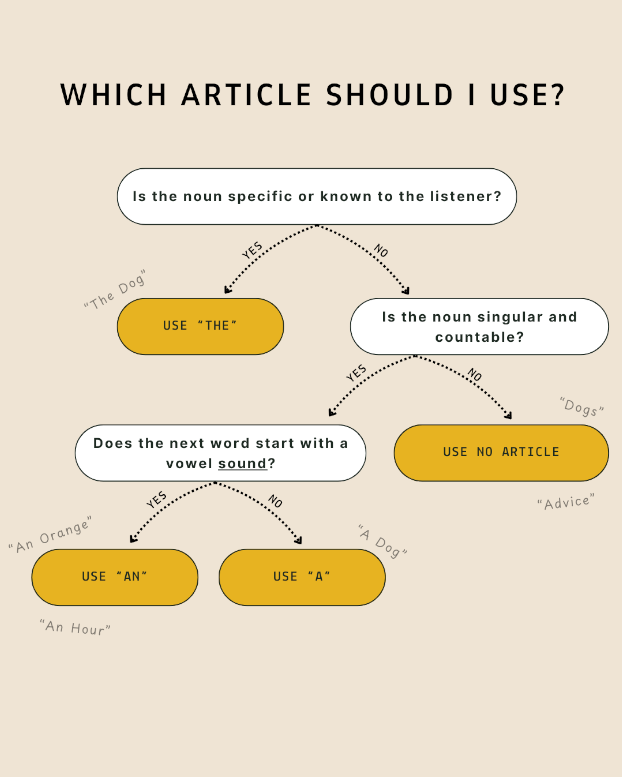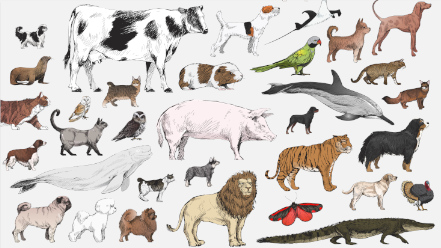
Master English Articles
Learn when to use indefinite, definite, and zero articles in English with this easy-to-follow guide. Use A, An, and The correctly.

Articles—small but powerful words like A, An, and The—are essential for clear and natural English. However, they’re one of the most challenging aspects of grammar for learners.
If your native language uses articles differently—or doesn’t use them—it’s natural to feel confused.
Mastering articles not only helps with grammar, but it also ensures your speech and writing sound more natural and professional.
Whether you’re writing professional emails, speaking in meetings, or preparing for exams, understanding when to use A, An, The, or nothing at all will make a huge difference in how you sound to others.
In this guide, we’ll talk about the three types of articles in English:
Articles are small words that help clarify which or how many things we’re talking about.
In English, articles provide context about whether something is specific or general, singular or plural, and familiar or new to the listener.
There are three types of articles in English:
Indefinite Articles (A/An) – Used when introducing something for the first time or when it’s not specific.
Definite Article (The) – Used when referring to a specific thing.
Zero Article (No Article) – Used when no article is needed.
Without articles, English sentences sound unnatural or unclear. Understanding them will help you speak and write more fluently—whether in conversations, emails, or exams.
Next, we’ll talk about indefinite vs. definite articles in more detail. The zero article is a little more difficult, so we’ll discuss that later.
Indefinite and definite articles help clarify whether we are talking about something specific or something general.
Examples:
This distinction is important because English speakers use A/An when mentioning something for the first time, and The when referring to something already introduced.
Once a noun has been mentioned, both the speaker and listener know which dog is being discussed, so we use The in the second example.
The decision to use A vs An depends on the word that follows the article.
If the next word begins with a vowel sound, use An.
If the next word begins with a consonant (non-vowel) sound, use A.
Notice, the choice depends on the sound, not the spelling! Keep that in mind.
Examples:
Use A before words that begin with a consonant sound.
Use An before words that begin with a vowel sound.
While A and An are used for singular nouns, when we’re referring to more than one indefinite noun, we use Some.
We also have to use Some when we’re talking about mass nouns – nouns that can’t be counted.
Mass nouns and the use of Some as an article can be tricky. We’ll discuss that in another Learning Hub article someday. For now, just know that Some is used for plural indefinite nouns and mass nouns.
The definite article The is used when referring to a specific noun that is known to both the speaker and the listener. This can be because:
The noun was mentioned earlier.
There is only one possible reference.
The noun is defined by context.
Unlike A/A, which are only for singular nouns, The can be used with both singular and plural nouns, so we don’t use Some here.
| Article | When to Use It | Singular or Plural? | Example |
|---|---|---|---|
| A | First mention of a singular noun, general/non-specific, the next word starts with a consonant sound | Singular only | I received a job offer from Google! |
| An | First mention of a singular noun, general/non-specific, the next word starts with a vowel sound | Singular only | She gave an excellent presentation. |
| The | Referring to a specific noun (previously mentioned or understood from context) | Singular or Plural | The job offers great benefits. |
| Some | Used for plural general/non-specific nouns | Plural only | The colleagues agreed to work together. / We received some feedback about the new project. |
| Zero | Used when speaking generally | Plural only | Dolphins are intelligent. |
We haven’t talked about the Zero Article, but that is coming up soon!
Remember, English speakers use A/An when mentioning something for the first time, and The when referring to something already introduced.
Articles can change the meaning of a sentence by shifting the focus from general to specific.
The last example is a general statement and uses the Zero Article, which is what we’ll talk about next!
In English, we don’t always use an article like A, An, or The before a noun. Sometimes, it’s incorrect to use any article at all.
When we don’t use an article, you can say we’re using the Zero Article.
In the situations below, English speakers skip the article, because the meaning is already clear from the context.
Proper Names
Talking About Things in General
Languages and Nationalities
School Subjects
Meals
Institutions
Time Expressions
It takes practice to get a feel for when to not use an article. The key is exposure—the more you listen to and read English, the more you’ll start to notice these patterns. Over time, you’ll develop an instinct for when to use articles and when to skip them.
So, take your time with this, and don’t be discouraged if it doesn’t make sense immediately. As a native English speaker, I know what sounds correct, but the rules don’t make sense to me either.
When it comes to using articles in English, there are several special rules and exceptions that can be a bit tricky. Don’t worry though—by understanding these exceptions, you can fine-tune the way you use articles and sound more natural when speaking and writing. Let’s look at some of these key situations.
Superlatives
Superlatives show the highest or most extreme degree of something. For these, we always use the definite article The because these are specific things.
Geographic Rules
Geographic names can be especially tricky, as some require The, while others don’t. Here are some key rules:
Use “The” with rivers, seas, and mountain ranges:
Use the Zero Article with individual mountains, cities, or lakes:
When it comes to countries, some names require “The”:
But most countries do not:
Idioms
There are also many idiomatic expressions in English where articles follow unique rules. You should never change the article when using one of these expressions.
British English Differences
You may come across some differences between British and American English usage. For example, in British English:
Even advanced English learners struggle with articles. The good news? With a little practice, you can avoid the most common mistakes. Let’s go over some key tips to help you use A, An, The, and the Zero Article correctly.
Using The when no article is needed
🚫 She loves the music. (Incorrect when speaking generally)
✅ She loves music. (No article for general ideas)
Forgetting The when talking about something specific
🚫 I saw cat outside.
✅ I saw the cat. (A cat that was previously mentioned in the conversation)
Using A/An with uncountable nouns
🚫 She gave me a great advice.
✅ She gave me great advice. (“Advice” is uncountable, so we use the Zero Article)
✅ She gave me a great piece of advice. (“Advice” is an uncountable, but “a piece” of advice can be counted and is singular, so we use A here)
Confusing A vs. An
🚫 He is an university student. (Incorrect because “university” starts with a consonant sound like “you”)
✅ He is a university student.
Here’s a simple chart to help you decide which article to use. You can save the image for studying!

The best way to master articles is to practice! Read, Listen, and Speak with someone who can correct your mistakes.
Pay attention to those little words in front of nouns. The more you focus on them, the sooner you’ll begin to notice patterns that will help you learn.
You can practice by reading and listening to the audiobooks available in our Audiobook Archive or by reading more posts in our Learning Hub.
Soon, you won’t have to think about articles anymore. The correct article for each situation will just feel natural.
Articles may seem like small words, but they play a big role in English. Using A, An, The, or Zero Article correctly can make your speech and writing sound more natural and fluent.
Key Takeaways:
Book a private lesson and work one-on-one with a professional tutor who can answer all of your questions to help you improve quickly!

Learn when to use indefinite, definite, and zero articles in English with this easy-to-follow guide. Use A, An, and The correctly.

Learn the names of all animals in English with audio. Which animal vocabulary should you learn first? Our list of 200+ animal grouped by level will help.

Learn essential business phrasal verbs and improve your professional communication. Practice with exercises, examples, and definitions.